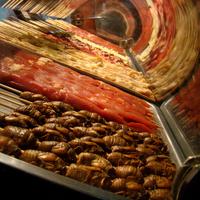
Apr 18, 2013
What seasonal delicacy will be in abundance this spring? The Brood II periodical cicada. For a short time after the little critters emerge along the Eastern Seaboard, they'll be ripe for the picking.
"Cicadas are really, really easy to catch. They just sit there. They don’t have any defensive mechanisms," explains Jenna Jadin, an AAAS fellow. During the Brood X emergence in 2004, while she was a graduate student at the university of Maryland, she and others helped field the cicada calls. Her specialty was the nutritional value of a cicada.
For fun, she put together a little cookbook called Cicada-Licious. There are over a dozen recipes in the book -- from "Shanghai Cicadas" to "Southern Cicada Tartlets."
Jadin says the it's best to do your cicada harvesting when they first emerge as tenerals -- their most succulent phase: “They’re a grub basically. They haven’t formed their exoskeleton yet. They haven’t hardened. Wings haven't unfurled.”
If you miss them in the teneral phase, Jadin recommends focusing your energies on female cicadas. “Females are full of fat and eggs and they actually have some substance to them."
As for preparation, she suggests boiling the cicada first thing, and working from there. Her favorite method is dry roasting, which she says helps the insect take on a nutty flavor. And in keeping with the old saying -- ok, my saying -- everything is better with chocolate, Jadin's favorite preparation involves dipping the crunchy bug bodies in chocolate.
She's not a fan of eating them raw, though. Imagine swallowing a mouthful of gnats and you can get a sense of the flavor profile. "There’s kind of an astringent quality to it. It’s not actually all that tasty," Jadin explained.
Before you start poring over recipes or binging on bugs, there are a few precautions you should take into consideration. First off, if you have a nut or shellfish allergy, you may want to pass on trying a cicada. There is some similarity between the insect and shellfish, so the allergy may carry over.
Second, enjoy in moderation. Jadin doesn't think it's likely, but before you eat a handful of cicadas, keep in mind that they've lived underground since 1996… meaning they could be reservoirs of pesticides and chemicals that have been applied to the ground over the last 17 years.
And let's face it, too much of any one food item can kill the magic. Jadin has firsthand experience. During the Brood X emergence, she and three of her grad school colleagues spent a day judging cicada dishes, tasting plate after plate.
"I have to say, by the end of the day, I was getting sick of cicadas.”

Correction: An earlier version of this post referred to the Brood II cicadas as "perennial," it's been corrected to describe them as "periodical."